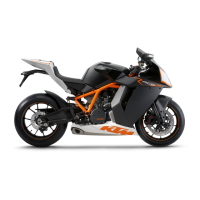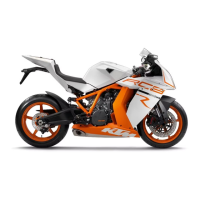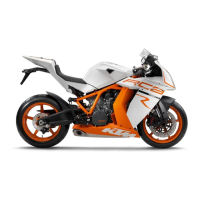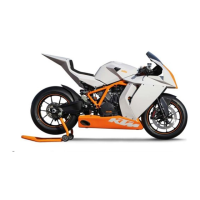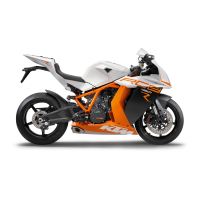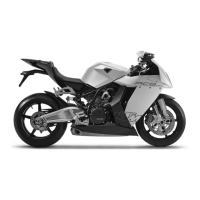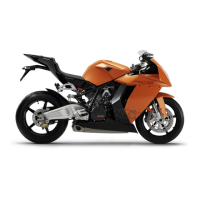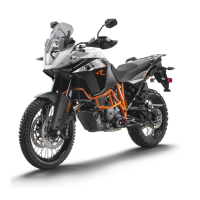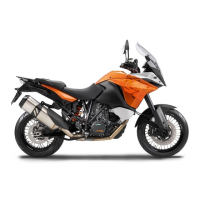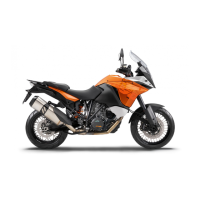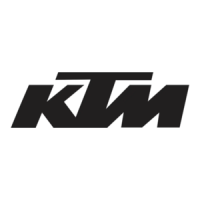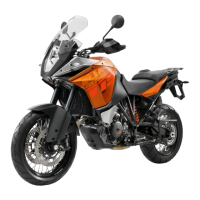Why do the headlight and parking light not work on my KTM 1190 RC8 R USA Motorcycle?
- RrileyadamSep 4, 2025
If the headlight and parking light do not work, the cause is likely a blown fuse 2. Change the fuses of individual power consumers.
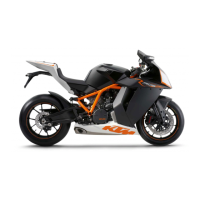
Why do the headlight and parking light not work on my KTM 1190 RC8 R USA Motorcycle?
If the headlight and parking light do not work, the cause is likely a blown fuse 2. Change the fuses of individual power consumers.
Why don't the brake light and horn work on my KTM 1190 RC8 R USA?
If the brake light and horn do not work, the issue is likely a blown fuse 3. In this case, change the fuses of individual power consumers.
What to do if combination instrument shows nothing in display on KTM 1190 RC8 R USA?
If the combination instrument shows nothing in the display, the cause is likely a blown fuse 1. Change the fuses of individual power consumers.
What to do if the speedometer in combination instrument doesn't work on my KTM 1190 RC8 R USA?
If the speedometer in the combination instrument doesn't work, the wiring harness of the wheel revolution counter may be damaged, or the plug-in connector might be oxidized. Check the wheel speed sensor.
Why KTM 1190 RC8 R USA engine doesn't crank when the electric starter button is pressed?
If your KTM Motorcycle engine doesn't crank when you press the electric starter, several factors could be at play. It could be due to an operating error; make sure you're following the correct start procedure. The battery might be discharged, so try recharging it. Also, check fuses 1 or 6 and the main fuse, and replace them if they're blown. The issue might stem from a defective ignition/steering lock, emergency OFF switch, or safety start system. Other potential causes include an active immobilizer, an unactivated EFI control unit, a malfunction in CAN bus communication, or a defective combination instrument.
Why is my KTM 1190 RC8 R USA Motorcycle battery discharged?
| Displacement | 1195 cc |
|---|---|
| Bore x Stroke | 105 mm x 69 mm |
| Compression Ratio | 12.5:1 |
| Fuel System | Electronic fuel injection |
| Transmission | 6-speed |
| Final Drive | Chain |
| Frame | Chromium-Molybdenum steel trellis frame, powder coated |
| Rear Suspension | WP monoshock |
| Front Tire | 120/70 ZR17 |
| Rear Tire | 190/55 ZR17 |
| Wheelbase | 1425 mm |
| ABS | Optional |
| Starter | Electric |
| Engine Type | V-Twin, 4-stroke |
| Front Suspension | WP USD |
| Front Brake | Dual 320 mm discs |
| Rear Brake | Brembo two piston caliper, 220 mm disc |
| Fuel Capacity | 16.5 liters |
Explains the meaning of symbols used throughout the manual.
Explains the typographical formats applied in the document.
Defines the intended operational use of the KTM motorcycle.
Provides essential safety instructions for operating the vehicle.
Defines risk levels and associated symbols for hazard warnings.
Illustrates and describes the various labels found on the motorcycle.
Outlines the procedure for reporting safety-related defects.
Provides critical guidelines for the safe operation of the vehicle.
Emphasizes the importance and requirements of protective riding gear.
Highlights the necessity of reading and retaining the owner's manual.
Details the conditions and scope of the vehicle's guarantee and warranty.
Information on required fluids, lubricants, and safe handling practices.
Advice on using approved spare parts and accessories for safety.
Stresses the significance of proper service and maintenance for optimal performance.
Diagram illustrating the front-left view of the motorcycle with labeled parts.
Diagram showing the rear-right view of the motorcycle with labeled components.
Details the location and identification of the VIN and type labels.
Information regarding the key number and the importance of the KEYCODECARD.
Specifies the location where the engine serial number is stamped.
Indicates the location of the part number on the front fork.
Identifies the location of the part number on the shock absorber.
Specifies the location of the part number for the steering damper.
Describes the clutch lever and its hydraulic, self-adjusting mechanism.
Explains the hand brake lever which operates the front brake.
Details the throttle grip located on the right handlebar.
Describes the operation of the light switch for low and high beam.
Explains how to operate the turn signal switch for left and right signals.
Details the function and operation of the emergency OFF switch.
Describes the ignition/steering lock and its operational states.
Provides an overview of the main components of the instrument cluster.
Details the tachometer, speed, gear, time, and temperature displays.
Explains the information display and its ROAD and RACE mode menus.
Lists and explains the function of various indicator lamps on the dashboard.
Shows the various screens available when the motorcycle is in ROAD mode.
Explains the ODO, Trip 1, Time 1, and Average Speed 1 displays.
Illustrates the different screens available when the motorcycle is in RACE mode.
Details how to navigate and access the various SET-UP menu options.
Describes how to switch between ROAD and RACE modes.
Instructions for setting the current time on the instrument cluster.
Accessing settings like shift warning light and lap button timing.
Procedure for activating and setting the shift RPM warning light.
Setting units for speed, distance, temperature, and fuel consumption.
Instructions on how to adjust engine mapping based on fuel quality.
Describes the procedure to switch between ROAD and RACE modes.
Detailed steps for setting the current time on the display.
Essential advice for initial operation and break-in period.
Guidelines and maximum speeds for the engine break-in process.
Precautions and weight limits for loading luggage onto the motorcycle.
Essential checks and maintenance steps before each ride.
Detailed steps for safely starting the motorcycle's engine.
Instructions on how to smoothly begin riding from a standstill.
Guidance on proper gear shifting and general riding techniques.
Explains correct braking methods and safety considerations.
Instructions for safely stopping and parking the motorcycle.
Recommendations for safely transporting the motorcycle.
Covers safety precautions and steps for refueling the fuel tank.
Table detailing required maintenance tasks at specific mileage/time intervals.
Introduces the adjustment options for the front fork and rear shock absorber.
Instructions for adjusting the front fork's compression damping.
Instructions for adjusting the front fork's rebound damping.
Procedure for adjusting the spring preload on the front fork.
Details on adjusting both high-speed and low-speed compression damping.
Instructions for adjusting the rebound damping on the rear shock absorber.
Procedure for adjusting the spring preload on the rear shock absorber.
Guidance on adjusting the steering damper for desired handling characteristics.
Instructions for adjusting the front and rear vehicle height settings.
How to adjust the footrest height and position for rider comfort.
Procedures for adjusting the shift lever stub and foot brake lever.
Detailed steps for adjusting the foot brake lever.
Instructions for modifying handlebar height and position.
Procedures for adjusting the subframe and rear frame height.
Instructions for safely raising the front and rear of the motorcycle.
Procedure for bleeding the air from the front fork legs.
Steps for removing and fitting the rider's and passenger's seats.
Procedures for cleaning the drive chain and adjusting its tension.
Detailed steps for checking and adjusting the drive chain tension.
Instructions for checking and correcting the hydraulic clutch fluid level.
Procedure for adjusting the basic position of the hand brake lever.
Guidance on checking brake discs for wear and damage.
Instructions on how to check the front brake fluid level.
Procedure for checking the wear on the front brake linings.
Instructions on how to check the rear brake fluid level.
Procedure for checking the wear on the rear brake linings.
Procedures for removing and installing the front wheel.
Procedures for removing and installing the rear wheel.
Guidance on inspecting tires for cuts, damage, tread depth, and age.
Instructions for checking and correcting tire air pressure.
Steps for safely removing and reinstalling the motorcycle battery.
Instructions on how to properly recharge the motorcycle battery.
Procedure for replacing the main fuse to protect the electrical system.
Instructions for replacing fuses for specific electrical components.
Step-by-step guide for changing low and high beam headlight bulbs.
Procedure for activating and deactivating motorcycle ignition keys.
General description of the motorcycle's cooling system operation.
Instructions on how to check the coolant level in the compensating tank.
Procedure for adding coolant to the system's compensating tank.
Guidance on checking the throttle cable for correct play.
Instructions for adjusting the throttle cable play.
How to check the engine oil level at normal operating temperature.
Procedures for changing the engine oil and oil filter.
Detailed steps for removing and installing the engine oil filter.
Instructions on how to properly fill the engine with the correct oil.
General guidelines for cleaning the motorcycle safely and effectively.
Specific maintenance steps for vehicles used in winter conditions.
Actions to take before storing the motorcycle for an extended period.
Steps to get the motorcycle ready for riding after storage.
Diagnosing and resolving issues related to engine starting.
Troubleshooting engine power loss and overheating.
Addressing EFI warning lamp indicators and engine stalling.
Diagnosing issues like oil consumption, lighting, battery, and display faults.
Interpreting blink codes from the immobilizer indicator lamp for diagnostics.
Diagnostic codes indicated by the EFI warning lamp (MIL).
Detailed technical data for the motorcycle's engine.
Specifications for tightening torques of various engine components.
Information on capacities for engine oil, coolant, and fuel.
Technical details regarding the chassis, fork, shock absorber, and brakes.
Data for the battery, fuses, bulbs, and other electrical components.
Details on front and rear tire sizes and types.
Detailed technical data for the front suspension fork.
Detailed technical data for the rear shock absorber.
Specifications for tightening torques of chassis-related components.
Information on DOT 4 and DOT 5.1 brake fluid standards and use.
Details on coolant type, mixture ratios, and antifreeze protection.
Specifications for engine oil type SAE 10W/50.
Specifications for engine oil type SAE 5W/40.
Specifications for the type of oil to use in the front fork.
Fuel recommendations for Super unleaded (ROZ 95/RON 95/PON 91).
Recommended products for cleaning and lubricating the drive chain.
Recommended fuel additive and long-life grease.
Recommended cleaners for motorcycle surfaces and materials.
Recommended universal oil spray for lubrication.
Explanation of the JASO T903 MA standard for motorcycle engine oils.
Explanation of SAE viscosity classification for oils.
